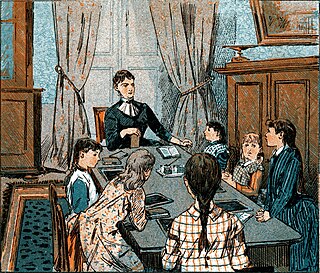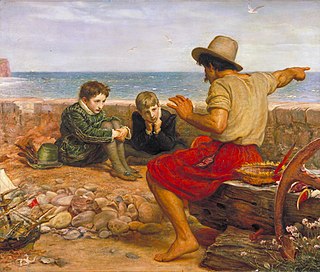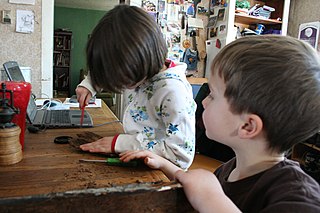See also

Teasing has multiple meanings and uses. In human interactions, teasing exists in three major forms: playful, hurtful, and educative. Teasing can have a variety of effects, depending on how it is used and its intended effect. [1] When teasing is unwelcome, it may be regarded as harassment or mobbing, especially in the workplace and school, or as a form of bullying or emotional abuse. If done in public, it may be regarded as humiliation. Teasing can also be regarded as educative when it is used as a way of informal learning. Adults in some of the Indigenous American communities often tease children to playfully illustrate and teach them how their behavior negatively affects the community. Children in many Indigenous American communities also learn by observing what others do in addition to collaborating with them. Along with teasing, this form of informal learning is different from the ways that Western American children learn. Informal ways of child learning include mutual responsibility, as well as active collaboration with adults and peers. This differentiates from the more formal way of learning because it is not adult-oriented.
People may be teased on matters such as their appearance, weight, behavior, family, gender, faith, health/medical issues, abilities, clothing, and intelligence. [2] From the victim's point of view, this kind of teasing is often hurtful, irrespective of the intention of the teaser.
One may also tease an animal. Some animals, such as dogs and cats, may recognize this both as play or harassment.
A common form of teasing is verbal bullying or taunting. This behavior is intended to distract, disturb, offend, sadden, anger, bother, irritate, or annoy the recipient. Because it is hurtful, it is different from joking and is generally accompanied by some degree of social rejection. Teasing can also be taken to mean "To make fun of; mock playfully" or be sarcastic about and use sarcasm.
Dacher Keltner uses Penelope Brown's classic study on the difference between "on-record" and "off-record" communication to illustrate how people must learn to read others' tone of voice and facial expressions in order to learn appropriate responses to teasing. [3]
A form of teasing that is usually overlooked is educational teasing. This form is commonly used by parents and caregivers in two Indigenous American communities and Mexican Heritage communities to guide their children into responding with more Prosocial behavior. For example, when a parent teases a child who is throwing a tantrum for a piece of candy, the parent will pretend to give the child candy but then take it away and ask the child to correct their behavior before giving the child that piece of candy. In this way, the parent teaches the child the importance of maintaining self-control. [4] When adults educate children through teasing, they are informally teaching the children. This type of learning is often overlooked because it is different from the way Western American Communities teach their children.[ citation needed ]
Another form of teasing is to pretend to give something which the other desires, or give it very slowly. This is usually done by arousing curiosity or desire, and may not actually involve the intent to satisfy or disclose. This form of teasing could be called "tantalizing", after the story of Tantalus. Tantalizing is generally playful among adults, although among children it can be hurtful, such as when one child acquires possession of another's property and will not return it. It is also common in flirting and dating. For example, a person who is interested in someone else romantically might reject an advance the first time in order to arouse interest and curiosity, and give in the second or third time.
Whether teasing is playful or hurtful or educative is largely subject to the interpretation of the person being teased. If the person being teased feels harmed, then the teasing is hurtful. A difference in power between people may also make the behavior hurtful rather than playful. Ultimately though, if someone perceives themselves as the victim of teasing, and experiences the teasing as unpleasant, then it is considered hurtful. If parents' intentions are positive, as in many Indigenous American communities, then teasing to the community can be seen as an educational tool. The child may or may not understand that at the moment. If the other person continues to do it after being asked to stop then it is a form of bullying or abuse.
Another way to look at teasing is as an honest reflection on differences, expressed in a joking fashion with the goal of "clearing the air". It can express comfort with the other which can be comforting. As opposed to being nice to someone's face while making disparaging remarks behind their back, teasing can be a way to express differences in a direct fashion rather than internalizing them.
Some indigenous American communities use teasing to teach their children about the expectations and values of the community and to change negative behaviors. Teasing gives children a better understanding of how their behavior affects the people around them. Teasing in Indigenous American communities is used to learn community acceptance, humbleness, correcting behavior and social control.
In some Mexican indigenous American communities, teasing is used in an effective educative way. Teasing is found more useful because it allows the child to feel and understand the relevant effect of their behavior instead of receiving out-of-context feedback. Some parents in Indigenous American communities believe it mildly embarrasses the children in a shared reference to give them a good sense of the consequences of their behavior. This type of teasing is thought to teach children to be less egocentric, teaches autonomy and responsibility to monitor their own behavior. [5] Parental teasing also is practiced to encourage the child to think of their behavior in a social context. Some Indigenous American mothers have reported that this urges the children to understand how their behavior affects others around them. From examples in Eisenberg's article, parents use teasing as a way of reinforcing relationships and participation in group/community activities (prosocial behavior). Parents tease their children to be able to "control the behavior of the child and to have fun with them". [6]
An Inuit principle of learning that follows a similar teasing pattern is known as issumaksaiyuk, meaning to cause thought. Oftentimes, adults pose questions or hypothetical situations to the children (sometimes dangerous) but in a teasing, playful manner, often dramatizing their responses. These questions raise the child's awareness to issues surrounding their community, as well as give them a sense of agency within the community as a member capable of having an effect and creating change. Once the child begins to answer the questions reasonably, like an adult, the questions would stop. [7]
In some Cherokee communities, teasing is a way of diffusing aggressive or hostile situations and teaching the individual about the consequences of their behavior. It allows the individual to feel how their behaviors are affecting others and control their behavior.
To tease, or to "be a tease" in a sexual sense can refer to the use of posture, language or other means of flirting to cause another person to become sexually aroused. Such teasing may or may not be a prelude to intercourse, an ambiguity which can lead to uncomfortable situations. In a more physical sense, it can also refer to sexual stimulation.
Teasing is also used to describe playing part of a song at a concert. Jam bands will often quote the main riff of another song during jams.
"Tease it" is also used as a slang term to smoke marijuana. The word "tease" can also be used as a noun to stand for marijuana.
In a very different context, hair can be teased, "ratted", or "backcombed". [8] As the name suggests, backcombing involves combing the hair backwards from end to root to intentionally tangle the strands to create volume. It can also be done excessively in sections to create dreadlocks.


Homeschooling or home schooling, also known as home education or elective home education (EHE), is the education of school-aged children at home or a variety of places other than a school. Usually conducted by a parent, tutor, or online teacher, many homeschool families use less formal, more personalized and individualized methods of learning that are not always found in schools. The actual practice of homeschooling varies considerably. The spectrum ranges from highly structured forms based on traditional school lessons to more open, free forms such as unschooling, which is a lesson- and curriculum-free implementation of homeschooling. Some families who initially attended a school go through a deschool phase to break away from school habits and prepare for homeschooling. While "homeschooling" is the term commonly used in North America, "home education" is primarily used in Europe and many Commonwealth countries. Homeschooling should not be confused with distance education, which generally refers to the arrangement where the student is educated by and conforms to the requirements of an online school, rather than being educated independently and unrestrictedly by their parents or by themselves.

In sociology, socialization is the process of internalizing the norms and ideologies of society. Socialization encompasses both learning and teaching and is thus "the means by which social and cultural continuity are attained".
Observational learning is learning that occurs through observing the behavior of others. It is a form of social learning which takes various forms, based on various processes. In humans, this form of learning seems to not need reinforcement to occur, but instead, requires a social model such as a parent, sibling, friend, or teacher with surroundings. Particularly in childhood, a model is someone of authority or higher status in an environment. In animals, observational learning is often based on classical conditioning, in which an instinctive behavior is elicited by observing the behavior of another, but other processes may be involved as well.

Parenting or child rearing promotes and supports the physical, emotional, social, spiritual and cognitive development of a child from infancy to adulthood. Parenting refers to the intricacies of raising a child and not exclusively for a biological relationship.

Storytelling is the social and cultural activity of sharing stories, sometimes with improvisation, theatrics or embellishment. Every culture has its own stories or narratives, which are shared as a means of entertainment, education, cultural preservation or instilling moral values. Crucial elements of stories and storytelling include plot, characters and narrative point of view. The term "storytelling" can refer specifically to oral storytelling but also broadly to techniques used in other media to unfold or disclose the narrative of a story.

Unschooling is an informal learning method that prioritizes learner-chosen activities as a primary means for learning. Unschoolers learn through their natural life experiences including play, household responsibilities, personal interests and curiosity, internships and work experience, travel, books, elective classes, family, mentors, and social interaction. Often considered a lesson- and curriculum-free implementation of homeschooling, unschooling encourages exploration of activities initiated by the children themselves, under the belief that the more personal learning is, the more meaningful, well-understood, and therefore useful it is to the child. While unschooled students may occasionally take courses, unschooling questions the usefulness of standard curricula, fixed times at which learning should take place, conventional grading methods and standardized tests, forced contact with children in their own age group, the compulsion to do homework regardless of whether it helps the learner in their individual situation, the effectiveness of listening to and obeying the orders of one authority figure for several hours each day, and other features of traditional schooling.
Abuse is the improper usage or treatment of a thing, often to unfairly or improperly gain benefit. Abuse can come in many forms, such as: physical or verbal maltreatment, injury, assault, violation, rape, unjust practices, crimes, or other types of aggression. To these descriptions, one can also add the Kantian notion of the wrongness of using another human being as means to an end rather than as ends in themselves. Some sources describe abuse as "socially constructed", which means there may be more or less recognition of the suffering of a victim at different times and societies.

Joy Berry is an American writer and child development specialist.
Social learning is learning that takes place at a wider scale than individual or group learning, up to a societal scale, through social interaction between peers.

Informal learning is characterized "by a low degree of planning and organizing in terms of the learning context, learning support, learning time, and learning objectives". It differs from formal learning, non-formal learning, and self-regulated learning, because it has no set objective in terms of learning outcomes, but an intent to act from the learner's standpoint. Typical mechanisms of informal learning include trial and error or learning-by-doing, modeling, feedback, and reflection. For learners this includes heuristic language building, socialization, enculturation, and play. Informal learning is a pervasive ongoing phenomenon of learning via participation or learning via knowledge creation, in contrast with the traditional view of teacher-centered learning via knowledge acquisition. Estimates suggest that about 70-90 percent of adult learning takes place informally and outside educational institutions.
Informal education is a general term for education that can occur outside of a traditional lecture or school based learning systems. The term even include customized-learning based on individual student interests within a curriculum inside a regular classroom, but is not limited to that setting. It could work through conversation, and the exploration and enlargement of experience. Sometimes there is a clear objective link to some broader plan, but not always. The goal is to provide learners with the tools they need to eventually reach more complex material. It can refer to various forms of alternative education, such as unschooling or homeschooling, autodidacticism (self-teaching), and youth work.

Play is a range of intrinsically motivated activities done for recreational pleasure and enjoyment. Play is commonly associated with children and juvenile-level activities, but may be engaged in at any life stage, and among other higher-functioning animals as well, most notably mammals and birds.
Learning through play is a term used in education and psychology to describe how a child can learn to make sense of the world around them. Through play children can develop social and cognitive skills, mature emotionally, and gain the self-confidence required to engage in new experiences and environments.

Consumer socialization is the process by which young people acquire skills, knowledge and attitudes relevant to their functioning as consumers in the marketplace. It has been argued, however, that consumer socialization occurs in the adult years as well. This field of study is a subdivision of consumer behavior as its main focus is on how childhood and adolescent experiences affect future consumer behavior. It attempts to understand how factors such as peers, mass media, family, gender, race, and culture play an influence in developing customer behavior.

Indigenous education specifically focuses on teaching Indigenous knowledge, models, methods, and content within formal or non-formal educational systems. The growing recognition and use of Indigenous education methods can be a response to the erosion and loss of Indigenous knowledge through the processes of colonialism, globalization, and modernity.
Emergent literacy is a term that is used to explain a child's knowledge of reading and writing skills before they learn how to read and write words. It signals a belief that, in literate society, young children—even one- and two-year-olds—are in the process of becoming literate. Through the support of parents, caregivers, and educators, a child can successfully progress from emergent to conventional reading.
Child work in indigenous American cultures covers child work, defined as the physical and mental contributions by children towards achieving a personal or communal goal, in Indigenous American societies. As a form of prosocial behavior, children's work is often a vital contribution towards community productivity and typically involves non-exploitative motivations for children's engagement in work activities. Activities can range from domestic household chores to participation in family and community endeavors. Inge Bolin notes that children's work can blur the boundaries between learning, play, and work in a form of productive interaction between children and adults. Such activities do not have to be mutually exclusive.

Styles of children’s learning across various indigenous communities in the Americas have been practiced for centuries prior to European colonization and persist today. Despite extensive anthropological research, efforts made towards studying children’s learning and development in Indigenous communities of the Americas as its own discipline within Developmental Psychology, has remained rudimentary. However, studies that have been conducted reveal several larger thematic commonalities, which create a paradigm of children’s learning that is fundamentally consistent across differing cultural communities.
Child integration is the inclusion of children in a variety of mature daily activities of families and communities. This contrasts with, for example, age segregation; separating children into age-defined activities and institutions. Integrating children in the range of mature family and community activities gives equal value and responsibility to children as contributors and collaborators, and can be a way to help them learn. Children's integration provides a learning environment because children are able to observe and pitch in as they feel they can.
Indigenous cultures in North America engage in storytelling about morality, origin, and education as a form of cultural maintenance, expression, and activism. Falling under the banner of oral tradition, it can take many different forms that serve to teach, remember, and engage Indigenous history and culture. Since the dawn of human history, oral stories have been used to understand the reasons behind human existence. Today, Indigenous storytelling is part of the broader indigenous process of building and transmitting indigenous knowledge.
![]() Media related to Teasing at Wikimedia Commons
Media related to Teasing at Wikimedia Commons